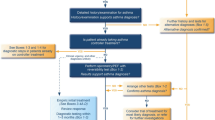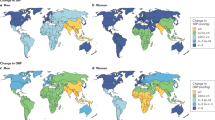Abstract
Background
Accumulating evidence suggests that pneumonia mortality is lower for individuals with high body mass index (BMI) compared to normal BMI, but it remains unclear whether weight change during adulthood influences subsequent mortality due to pneumonia in Asian populations, who have a relatively lean body mass. This study aimed to examine the association of BMI and weight change over 5 years with the subsequent risk of pneumonia mortality in a Japanese population.
Methods
The present analysis included 79,564 Japan Public Health Center (JPHC)-based Prospective Study participants who completed a questionnaire between 1995 and 1998 were followed for death through 2016. BMI was categorized into four groups: underweight (<18.5 kg/m2), normal weight (BMI: 18.5–24.9 kg/m2), overweight (25.0–29.9 kg/m2), and obese (BMI: ≥30.0 kg/m2). Weight change was defined as the difference of body weight between questionnaire surveys with a 5-year interval. Cox proportional hazards regression was used to estimate hazard ratios of baseline BMI and weight change for pneumonia mortality.
Results
During a median follow-up of 18.9 y, we identified 994 deaths from pneumonia. Compared with participants with normal weight, an elevated risk was observed among those who were underweight (hazard ratio = 2.29, 95% confidence interval [CI]: 1.83–2.87), whereas a decreased risk was found among those who were overweight (hazard ratio = 0.63, 95% CI: 0.53–0.75). Regarding weight change, the multivariable-adjusted hazard ratio (95% CI) of pneumonia mortality for a weight loss of 5 kg or more versus a weight change of less than 2.5 kg was 1.75 (1.46–2.10), whereas that for a weight gain of 5 kg or more was 1.59 (1.27–2.00).
Conclusion
Underweight and greater weight change was associated with an increase in the risk of pneumonia mortality in Japanese adults.
This is a preview of subscription content, access via your institution
Access options
Subscribe to this journal
Receive 12 print issues and online access
$259.00 per year
only $21.58 per issue
Buy this article
- Purchase on Springer Link
- Instant access to full article PDF
Prices may be subject to local taxes which are calculated during checkout


Similar content being viewed by others
Data availability
Access to Japan Public Health Centre-based Prospective Study data will be made available upon reasonable request. Please follow the instructions at https://epi.ncc.go.jp/en/jphc/805/8155.html.
References
Troeger C, Blacker B, Khalil IA, Rao PC, Cao J, Zimsen SRM, et al. Estimates of the global, regional, and national morbidity, mortality, and aetiologies of lower respiratory infections in 195 countries, 1990–2016: a systematic analysis for the Global Burden of Disease Study 2016. Lancet Infect Dis. 2018;18:1191–210.
Statistics bureau of Japan. [Portal site of official statistics of Japan (e-Stat)]. Available online: https://www.e-stat.go.jp (Accessed 17 December 2022).
Almirall J, Serra-Prat M, Bolíbar I, Balasso V. Risk factors for community-acquired pneumonia in adults: a systematic review of observational studies. Respiration. 2017;94:299–311.
Ritz BW, Gardner EM. Malnutrition and energy restriction differentially affect viral immunity. J Nutr. 2006;136:1141–4.
Karlsson EA, Beck MA. The burden of obesity on infectious disease. Exp Biol Med. 2010;235:1412–24.
Phung DT, Wang Z, Rutherford S, Huang C, Chu C. Body mass index and risk of pneumonia: a systematic review and meta-analysis. Obes Rev. 2013;14:839–57.
Hamer M, O’Donovan G, Stamatakis E. Lifestyle risk factors, obesity and infectious disease mortality in the general population: linkage study of 97,844 adults from England and Scotland. Prev Med. 2019;123:65–70.
Inoue Y, Koizumi A, Wada Y, Iso H, Watanabe Y, Date C, et al. Risk and protective factors related to mortality from pneumonia among middleaged and elderly community residents: the JACC Study. J Epidemiol. 2007;17:194–202.
Takata Y, Ansai T, Soh I, Akifusa S, Sonoki K, Fujisawa K, et al. Association between body mass index and mortality in an 80-year-old population. J Am Geriatr Soc. 2007;55:913–7.
Nakayama K, Koyohara Y, Kato I, Iwamoto H, Ueda K, Fujishima M. Effect of body mass index on morbidity and mortality in a general Japanese population–the Hisayama study. Nihon Ronen Igakkai Zasshi. 1997;34:935–41.
Nie W, Zhang Y, Jee SH, Jung KJ, Li B, Xiu Q. Obesity survival paradox in pneumonia: a meta-analysis. BMC Med. 2014;12:61.
Ministry of Health, Labour and Welfare, Japan. The National Health and Nutrition Survey in Japan, 2019. Available online: https://www.mhlw.go.jp/stf/seisakunitsuite/bunya/kenkou_iryou/kenkou/eiyou/r1-houkoku_00002.html (in Japanese) (Accessed 17 December 2022).
LaCroix AZ, Lipson S, Miles TP, White L. Prospective study of pneumonia hospitalizations and mortality of U.S. older people: the role of chronic conditions, health behaviors, and nutritional status. Public Health Rep. 1989;104:350–60.
Loftfield E, Freedman ND, Graubard BI, Guertin KA, Black A, Huang WY, et al. Association of coffee consumption with overall and cause-specific mortality in a large US prospective cohort study. Am J Epidemiol. 2015;182:1010–22.
Watanabe I, Kuriyama S, Kakizaki M, Sone T, Ohmori-Matsuda K, Nakaya N, et al. Green tea and death from pneumonia in Japan: the Ohsaki cohort study. Am J Clin Nutr. 2009;90:672–9.
Hemilä H, Louhiala P. Vitamin C may affect lung infections. J R Soc Med. 2007;100:495–8.
Zhou YF, Luo BA, Qin LL. The association between vitamin D deficiency and community-acquired pneumonia: a meta-analysis of observational studies. Medicine. 2019;98:e17252.
Barnett JB, Hamer DH, Meydani SN. Low zinc status: a new risk factor for pneumonia in the elderly? Nutr Rev. 2010;68:30–7.
Nanri A, Mizoue T, Takahashi Y, Noda M, Inoue M, Tsugane S. Weight change and all-cause, cancer and cardiovascular disease mortality in Japanese men and women: the Japan Public Health Center-Based Prospective Study. Int J Obes (Lond). 2010;34:348–56.
Mulligan AA, Lentjes MAH, Luben RN, Wareham NJ, Khaw KT. Weight change and 15 year mortality: results from the European prospective investigation into Cancer in Norfolk (EPIC-Norfolk) cohort study. Eur J Epidemiol. 2018;33:37–53.
Tsugane S, Sawada N. The JPHC study: design and some findings on the typical Japanese diet. Jpn J Clin Oncol. 2014;44:777–82.
World Health Organization. Obesity: Preventing and Managing the Global Epidemic. WHO Technical Report Series 894. 2000. Available online: https://apps.who.int/iris/handle/10665/42330 (Accessed 17 December 2022).
Tsugane S, Sasaki S, Tsubono Y. Under- and overweight impact on mortality among middle-aged Japanese men and women: a 10-y follow-up of JPHC study cohort I. Int J Obes Relat Metab Disord. 2002;26:529–37.
Nanri A, Mizoue T, Takahashi Y, Matsushita Y, Noda M, Inoue M, et al. Association of weight change in different periods of adulthood with risk of type 2 diabetes in Japanese men and women: the Japan Public Health Center-Based Prospective Study. J Epidemiol Community Health. 2011;65:1104–10.
World Health Organization. ICD-10: International Statistical Classification of Diseases and Related Health Problems: 10th Revision. World Health Organization; 1992.
Sasaki S, Kobayashi M, Ishihara J, Tsugane S. Self-administered food frequency questionnaire used in the 5-year follow-up survey of the JPHC Study: questionnaire structure, computation algorithms, and area-based mean intake. J Epidemiol. 2003;13:S13–22.
Science and Technology Agency. 5th revised and enlarged. Printing Bureau of the Ministry of Finance, 2005. [Standard Tables of Food Composition in Japan].
Sasaki S, Ishihara J, Tsugane S. Reproducibility of a self-administered food frequency questionnaire used in the 5-year follow-up survey of the JPHC Study Cohort I to assess food and nutrient intake. J Epidemiol. 2003;13:S115–24.
Ishihara J, Sobue T, Yamamoto S, Yoshimi I, Sasaki S, Kobayashi M, et al. Validity and reproducibility of a self-administered food frequency questionnaire in the JPHC Study Cohort II: study design, participant profile and results in comparison with Cohort I. J Epidemiol. 2003;13:S134–47.
Gavazzi G, Herrmann F, Krause KH. Aging and infectious diseases in the developing world. Clin Infect Dis. 2004;39:83–91.
Pan XF, Yuan JM, Koh WP, Pan A. Weight change in relation to mortality in middle-aged and elderly Chinese: the Singapore Chinese Health Study. Int J Obes (Lond). 2019;43:1590–600.
Deeg DJ, Miles TP, Van Zonneveld RJ, Curb JD. Weight change, survival time and cause of death in Dutch elderly. Arch Gerontol Geriatr. 1990;10:97–111.
Walston J, Hadley EC, Ferrucci L, Guralnik JM, Newman AB, Studenski SA, et al. Research agenda for frailty in older adults: toward a better understanding of physiology and etiology: summary from the American Geriatrics Society/National Institute on Aging Research Conference on Frailty in Older Adults. J Am Geriatr Soc. 2006;54:991–1001.
Xie WQ, Xiao GL, Fan YB, He M, Lv S, Li YS. Sarcopenic obesity: research advances in pathogenesis and diagnostic criteria. Aging Clin Exp Res. 2021;33:247–52.
Chiolero A, Faeh D, Paccaud F, Cornuz J. Consequences of smoking for body weight, body fat distribution, and insulin resistance. Am J Clin Nutr. 2008;87:801–9.
Bello S, Menéndez R, Antoni T, Reyes S, Zalacain R, Capelastegui A, et al. Tobacco smoking increases the risk for death from pneumococcal pneumonia. Chest. 2014;146:1029–37.
Mancuso P. Obesity and lung inflammation. J Appl Physiol. 2010;108:722–8.
Shade ED, Ulrich CM, Wener MH, Wood B, Yasui Y, Lacroix K, et al. Frequent intentional weight loss is associated with lower natural killer cell cytotoxicity in postmenopausal women: possible long-term immune effects. J Am Diet Assoc. 2004;104:903–12.
Culley FJ. Natural killer cells in infection and inflammation of the lung. Immunology. 2009;128:151–63.
Acknowledgements
We are indebted to the Aomori, Iwate, Ibaraki, Niigata, Osaka, Kochi, Nagasaki, and Okinawa Cancer Registries for providing their incidence data. We would like to thank all members of the Japan Public Health Center-based Prospective Study Group for their valuable contributions. JPHC study members (as of April 2021) are listed at: https://epi.ncc.go.jp/en/jphc/781/8896.html.
Funding
This work was supported by the National Cancer Center Research and Development Fund (23-A-31[toku], 26-A-2 and 29-A-4) (since 2011), a Grant-in-Aid for Cancer Research from the Ministry of Health, Labour and Welfare of Japan (from 1989 to 2010). The funders had no role in the design and conduct of the study; collection, management, analysis, and interpretation of the data; preparation, review, and approval of the manuscript; and the decision to submit the manuscript for publication.
Author information
Authors and Affiliations
Contributions
ST was involved in the design of the study as the principal investigator; ST and NS conducted the surveys; T Miki, AN, T Mizoue, AG, MN. NS, and ST drafted the plan for data analyses; T Miki conducted the data analyses; T Mizoue provided statistical expertise; T Miki drafted the manuscript; T Miki, and T Mizoue had primary responsibility for the final content. All authors were involved in the interpretation of the results and revision of the manuscript and approved the final version of the manuscript.
Corresponding author
Ethics declarations
Competing interests
The authors declare no competing interests.
Additional information
Publisher’s note Springer Nature remains neutral with regard to jurisdictional claims in published maps and institutional affiliations.
Supplementary information
Rights and permissions
Springer Nature or its licensor (e.g. a society or other partner) holds exclusive rights to this article under a publishing agreement with the author(s) or other rightsholder(s); author self-archiving of the accepted manuscript version of this article is solely governed by the terms of such publishing agreement and applicable law.
About this article
Cite this article
Miki, T., Nanri, A., Mizoue, T. et al. Association of body mass index and weight change with pneumonia mortality in a Japanese population: Japan Public Health Center-based Prospective Study. Int J Obes 47, 479–486 (2023). https://doi.org/10.1038/s41366-023-01289-2
Received:
Revised:
Accepted:
Published:
Issue Date:
DOI: https://doi.org/10.1038/s41366-023-01289-2



